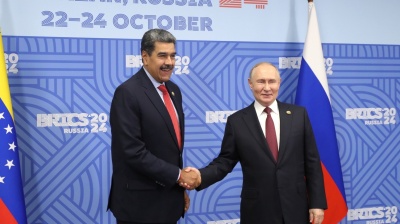Bilateral trade between China and Russia declined in the first half of 2025, but the downturn masks a deeper entrenchment of economic ties that continue to sustain Moscow’s war effort in Ukraine, according to a note by Maciej Kalwasiński, a political analyst at the Centre for Eastern Studies (OSW).
While total trade volumes fell, the contraction was driven by a handful of categories and fails to reflect the strategic nature of China’s ongoing support.
Chinese customs data show that exports to Russia declined by 8.4%, while imports dropped by 9.6% year-on-year. However, the fall was disproportionately driven by lower shipments of crude oil, coal and vehicles. Kalwasiński notes that the “downturn can be largely attributed to specific product categories,” highlighting instead the persistence of flows in dual-use technologies and the structural evolution of the trade relationship. This month a drone manufactured entirely using Chinese components was found for the first time on the battlefield in Ukraine.
The most significant declines on China’s import side were in energy commodities. “Crude oil, fuel oils and bituminous coal accounted for the bulk of the $6.3bn drop in total imports,” Kalwasiński said, attributing the fall to new US sanctions, lower global prices and a high comparison base from 2024. Russian oil shipments to China dropped by 11% in volume and 24% in value, cutting Russia’s share of Chinese oil imports to 17.5% — the lowest in two years.
On the export side, China’s shipments of passenger cars to Russia fell by 59%, primarily due to Moscow’s protectionist measures. Kalwasiński explained that Russia raised vehicle recycling fees by up to 85%, making imports significantly more expensive and incentivising local production. “Chinese cars remain welcome — but only if they are made in Russia,” he said. Exports of car parts, in contrast, surged, indicating a shift toward local assembly using Chinese components.
Despite these disruptions, China has not retaliated. “Beijing has made no visible effort to pressure the Kremlin to reverse course,” Kalwasiński observed, even as these trade barriers constrain consumer choice and purchasing power in Russia. Imports of cars and smartphones dropped by 29% amid high inflation and weakening demand.
While overall trade has weakened, China continues to supply Russia with dual-use goods critical to its military effort. In the first half of 2025, Beijing exported $1.9bn in items designated by the US and its allies as “high priority” dual-use technologies, including printed circuits, drone optics and targeting equipment. “China has remained Moscow’s key source of supply,” Kalwasiński said, “amid the collapse of deliveries from other major partners.”
Other exports, such as manganese ores used in hardened steel and turbojet engines likely destined for military aircraft, have surged. Exports of ballistic fibres for body armour and residual categories of engines and synchronised devices — often used in drones — have also spiked.
“By continuing to publish detailed customs data, Beijing openly signals its disregard for Western trade sanctions against Russia,” Kalwasiński noted. However, he cautioned that what is disclosed “reveals only what China chooses to make visible” — with the true scale of support potentially extending beyond official figures.



Opinion

COMMENT: Czechia economy powering ahead, Hungary’s economy stalls
Early third-quarter GDP figures from Central Europe point to a growing divergence between the region’s two largest economies outside Poland, with Czechia accelerating its recovery while Hungary continues to struggle.

COMMENT: EU's LNG import ban won’t break Russia, but it will render the sector’s further growth fiendishly hard
The European Union’s nineteenth sanctions package against Russia marks a pivotal escalation in the bloc’s energy strategy, which will impose a comprehensive ban on Russian LNG imports beginning January 1, 2027.

Western Balkan countries become emerging players in Europe’s defence efforts
The Western Balkans could play an increasingly important role in strengthening Europe’s security architecture, says a new report from the Carnegie Europe think-tank.

COMMENT: Sanctions on Rosneft and Lukoil are symbolic and won’t stop its oil exports
The Trump administration’s sanctions on Russian oil giants Rosneft and Lukoil, announced on October 22, may appear decisive at first glance, but they are not going to make a material difference to Russia’s export of oil, says Sergey Vakulenko.




